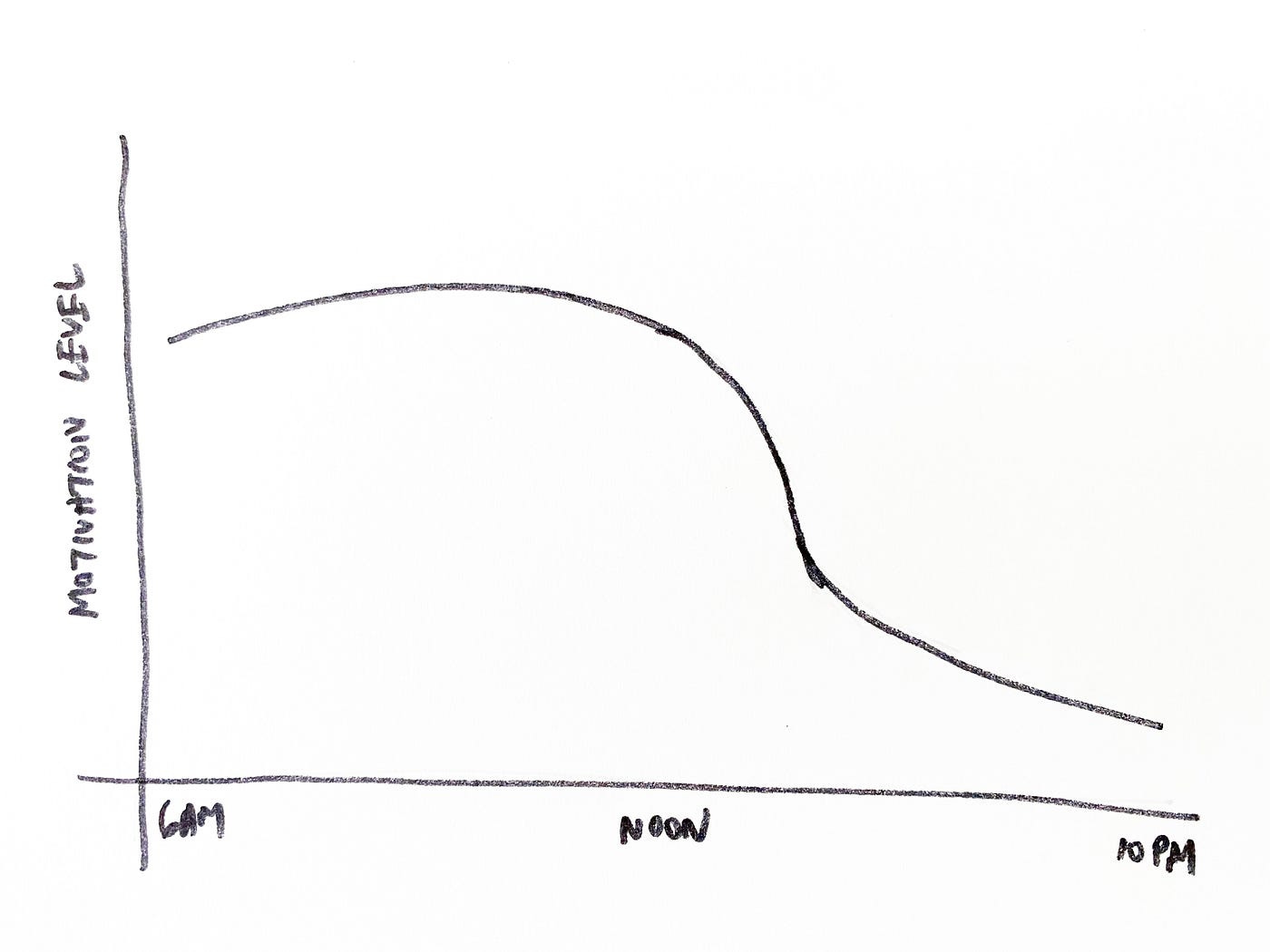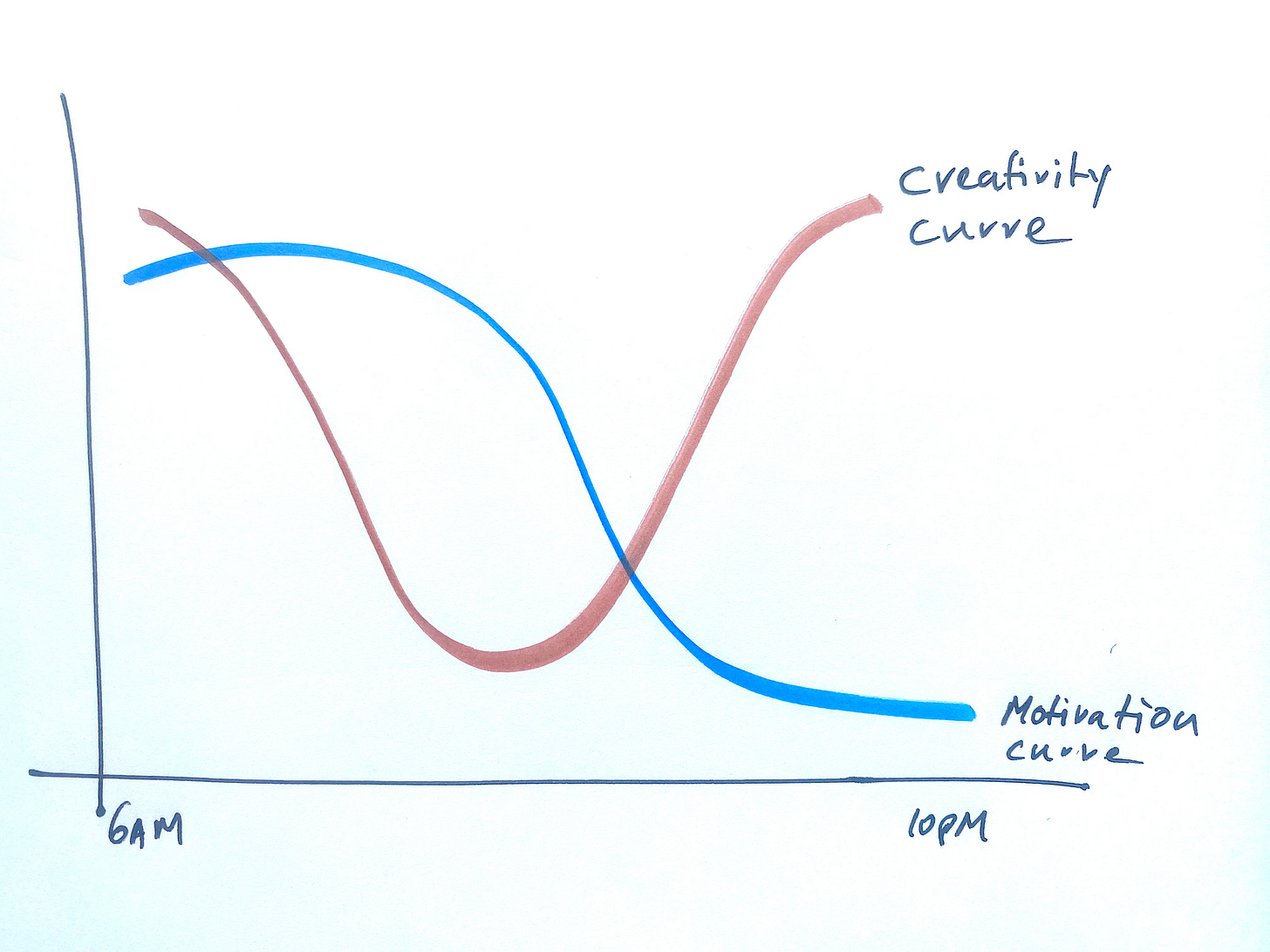Interleaving and Chunking: Two Underrated Productivity Weapons
People will tell you to focus on one thing. But here's why you should work on multiple projects and chase multiple dreams.
The common notion is that having many dreams and goals and working on multiple projects fragments your attention, and so is not a good thing.
In today’s letter, we’ll explore why that’s mostly nonsense.
How motivation works and how you should harness it
Isn’t it true: Some days you’re so motivated you get a lot done quickly. But the intensity eventually wears out, and your days feel like a drag again. Even within a single day, motivation can be high in the morning and low in the afternoon.
Motivation is driven by two things: hope and mood.
Hope is the possibility of good things to come. What increases hope is clarity: knowing you are on the right path. You can’t stay motivated if you’re unsure where you’re headed.
Mood, on the other hand, is influenced by diet, physical activity, life events, and, yes, even the news. But there’s one thing that affects mood no matter who you are or how good your life is: time of day.
Our motivation levels naturally ebb and flow throughout the day. My motivation curve typically looks like this:
So, a quick hack you can apply right away is to chart out your motivation curve and restructure your day so you’re doing boring work when the curve is high and fun work when the curve is low. As for me, I debug code (which I find boring) in the morning and edit photos in the afternoon. Editing photos is fun enough that I can reserve that activity for times when I’m not as motivated. Not so with fixing bugs.
Of course, there’s also the creativity curve: creativity levels can fluctuate throughout the day. For example, I find writing easier early in the morning or late at night. So, it’s often about finding harmony between your motivation and creativity curves. But I’ve found that prioritizing based on the motivation curve generally is more effective.
Bottom line: how you structure your day is more critical than you might think.
Interleaving leverages your brain to the max
Interleaving is my secret weapon for juggling my different projects, hobbies, and goals.
My guess is many of you are ambitious and have many interests.
Me too. My interests are wide-ranging: photography, piano, software projects, and podcasting, to name a few.
People will advise you to focus on one thing. You’ll hear quotes like “chase two rabbits and you catch none.”
Sure, having only one focus in life can be effective, and many successful people gained their success by having razor-sharp focus on just one thing for a very long time. Even Vivekananda, someone I look up to, said this:
Take up one idea. Make that one idea your life; dream of it; think of it; live on that idea. Let the brain, the body, muscles, nerves, every part of your body be full of that idea, and just leave every other idea alone. This is the way to success.
–VivekanandaBut there's a risk in getting trapped by cookie-cutter philosophies and ideologies. People’s perspectives are deeply biased by their personal journeys. One successful person will tell you the key to success is to work hard, get to work early, leave late, kiss up to your boss, and get promoted. Another will tell you to be a business owner, try out different things, and double down on what works. Everybody’s advice is biased by what path they took.
Here’s my view: pursue all your interests. Not only is it possible, but we’re going to see that it’s also beneficial!
When you do just one thing, your brain eventually gets fried, and continuing to focus on that activity will give you diminishing returns. The secret to avoiding this is to switch to another activity that engages a different part of your brain. This is interleaving, and it is underrated.
For example, after an intense coding session, I might shift to piano practice. This is why the piano hobby is not only possible for me but also a helpful thing to have in life. It doesn’t have to be a completely different activity. Sometimes, I’ll switch from one coding project to another coding project–as long as it stimulates a different area of my brain, that’s all that’s needed. When you switch, your motivation level gets a bump, and you’re essentially leveraging an extra gear in your brain.
Even if your brain isn’t fried after working on something for too long, you’ll still start to develop tunnel vision. You’ll get too close to your work and start to lose judgment. It happens all the time to photographers when we’re editing photos. When this happens, we stop editing and return to it in a day or two. That mental space works like magic. But the takeaway here is you don’t have to be idle during this period. Just switch to a different activity that engages a different part of your brain.
Listen to Shashank Khanna (International Landscape Photographer of the Year, Top 100) talk about how he deals with tunnel vision.
No wonder studies show that the average person is productive only for three hours a day–it’s most likely due to the monotonous focus that’s typical in work settings.
In case you’re wondering: Interleaving doesn't prevent you from reaching a flow state, where you're fully engrossed and your work feels effortless. If I'm in flow, I’m not going to switch to another activity. It's only when my motivation starts to fall that I move on to something else. In fact, interleaving makes it possible to experience multiple flow states every day.
Chunking, the secret to effective weekly planning
The interesting thing about interleaving is that it works not only in a daily context but also in broader timeframes like weeks. And that brings us to chunking.
Chunking is when you batch related tasks together.
If you have a bunch of errands to run, do them all in one chunk. If you have a bunch of administrative tasks to take care of (paying bills, responding to emails, etc), chunk those together.
Why is chunking important?
Because every time you start a new activity, there’s usually an overhead cost in terms of your attention. Cal Newport in his book "Deep Work" says that everytime you switch tasks, it takes about 25 minutes for your focus to fully shift to the new task. He calls this attention residue. By grouping related tasks and approaching them as if they were a single task, you reduce the number of task switches you make.
So now, rather than interleaving between a whole lot of things, you are only interleaving between a few broad life areas. In my case, that’s my day job, photography, piano, and software projects. As we’ll see soon, my weekly planning is all about how I divide my time between these four broad areas.
I hope this discussion on motivation curve, interleaving, and chunking helps you see that working on multiple projects and chasing multiple dreams is not only not a bad thing but also beneficial.







